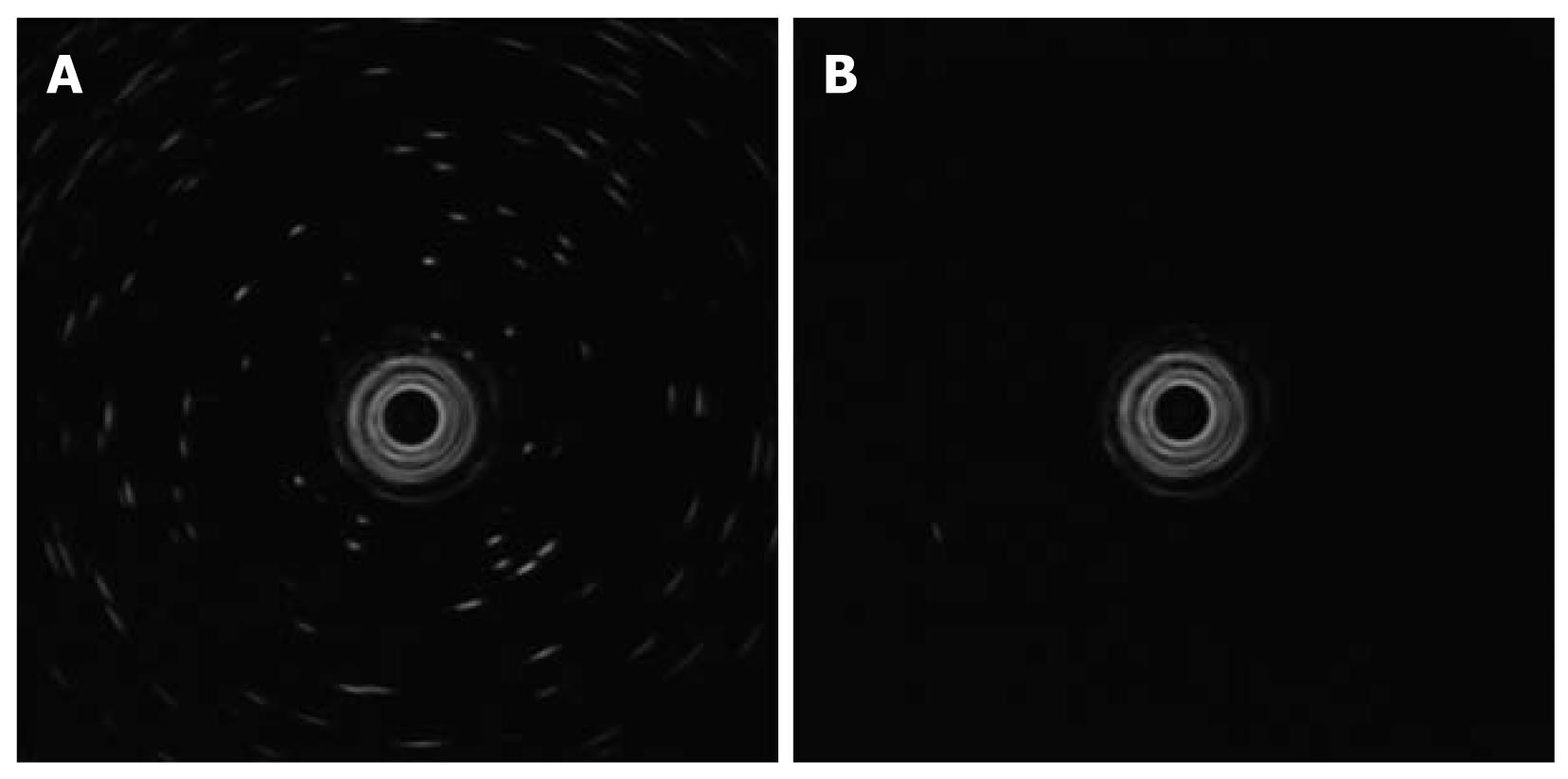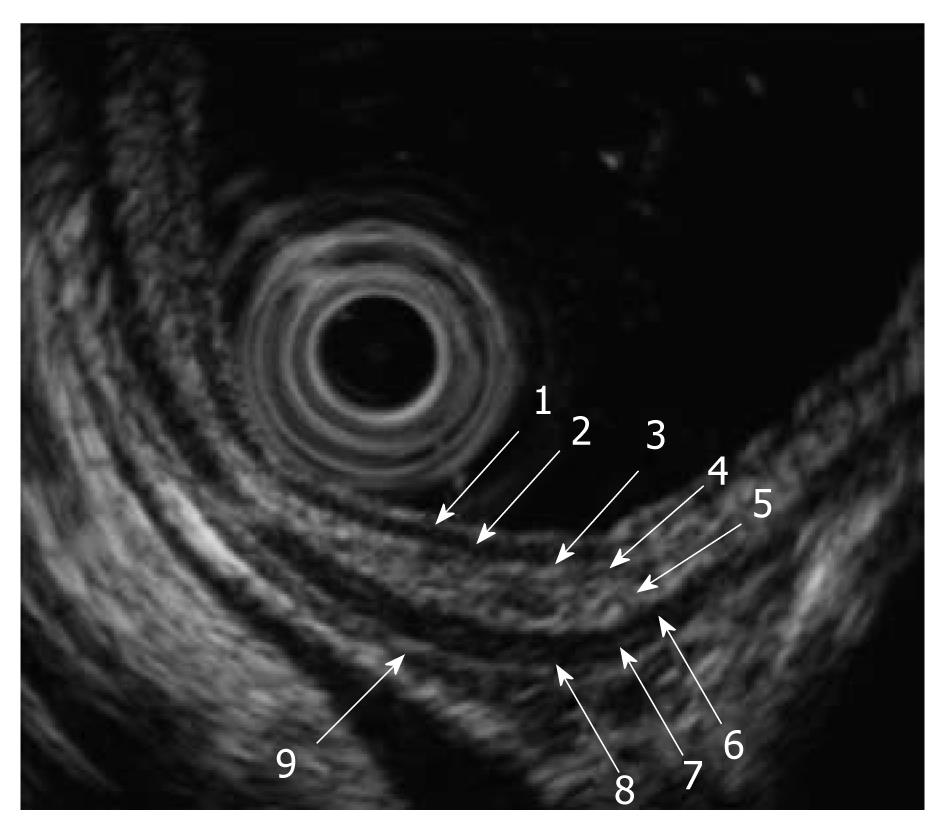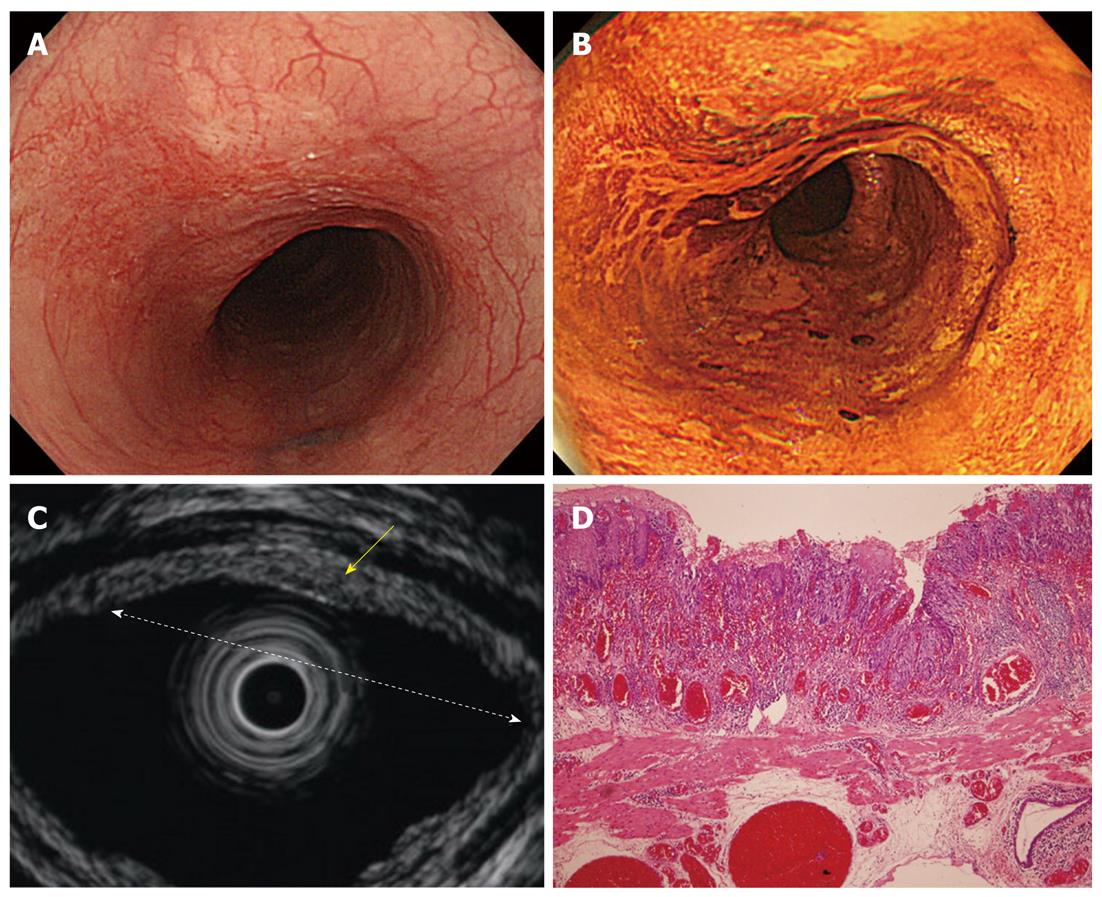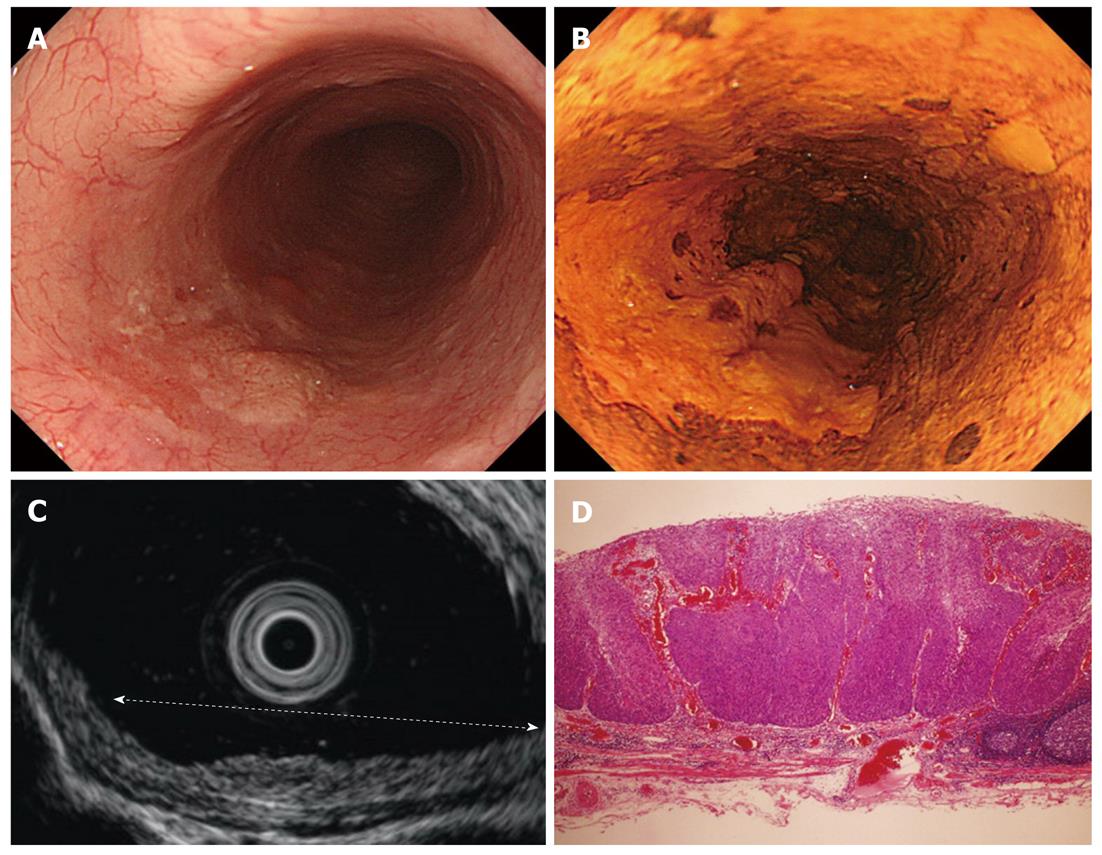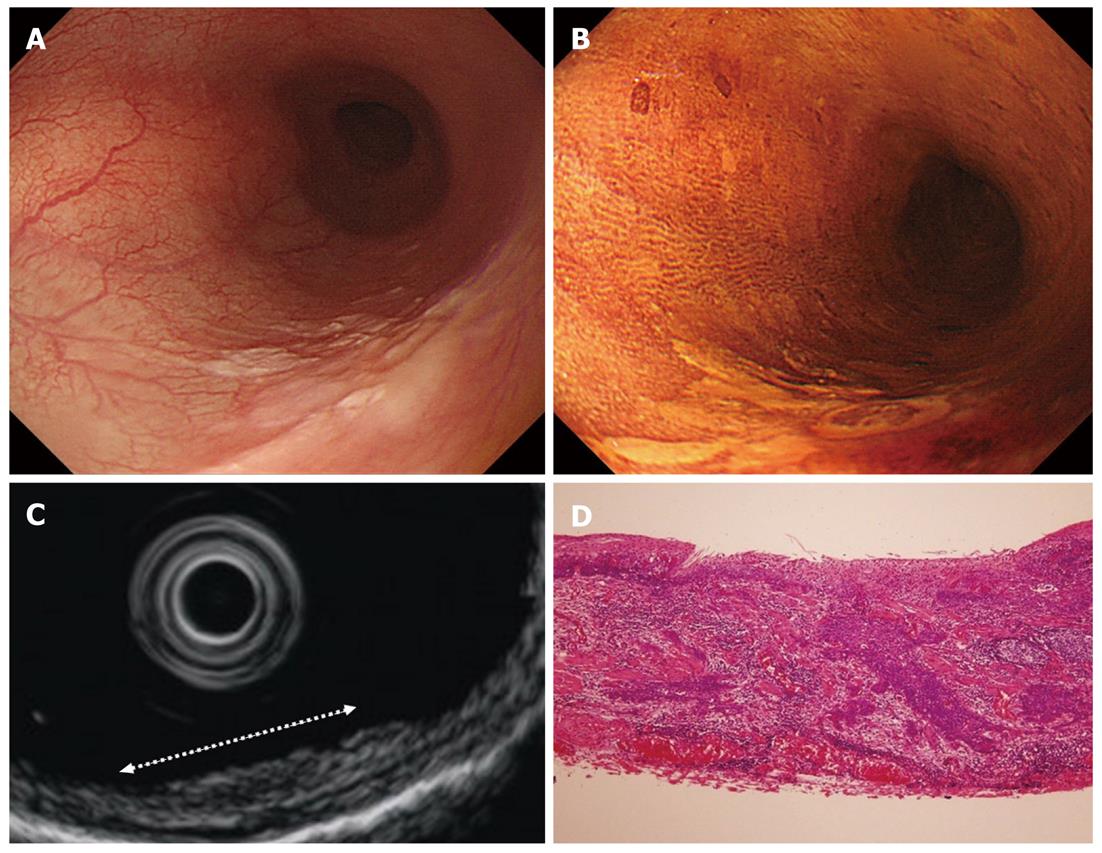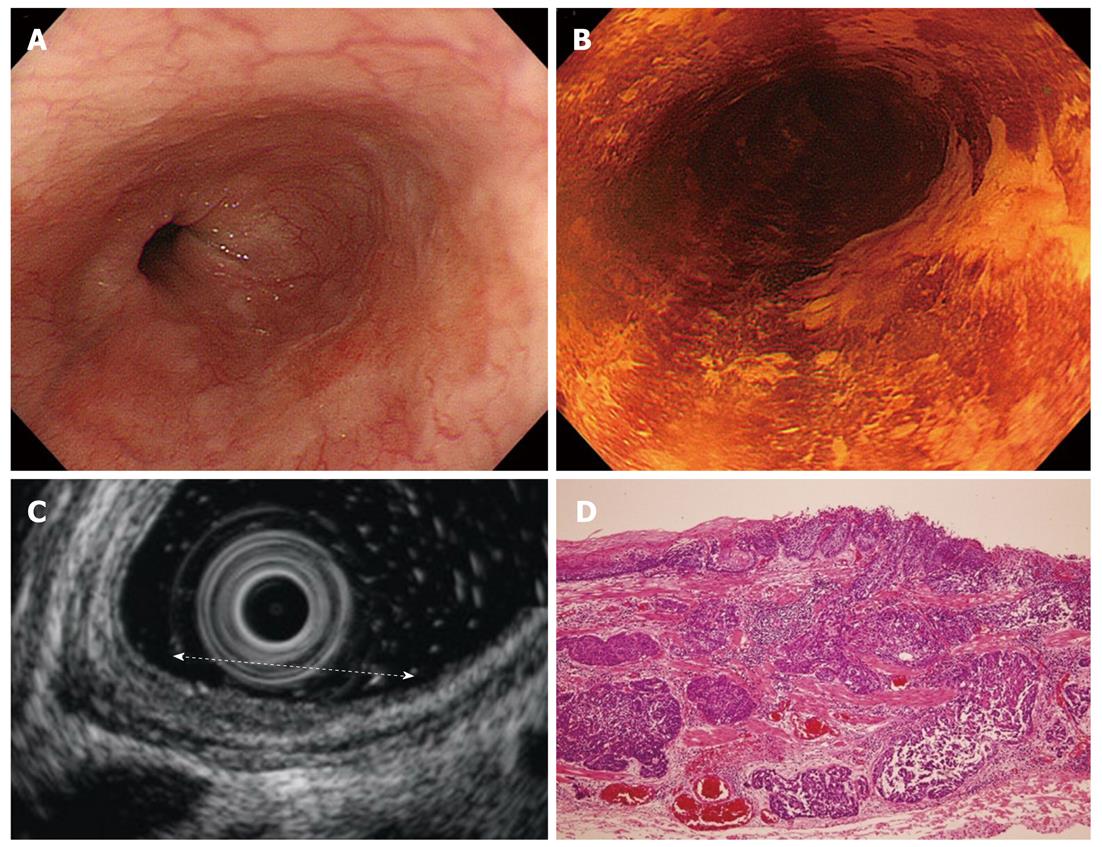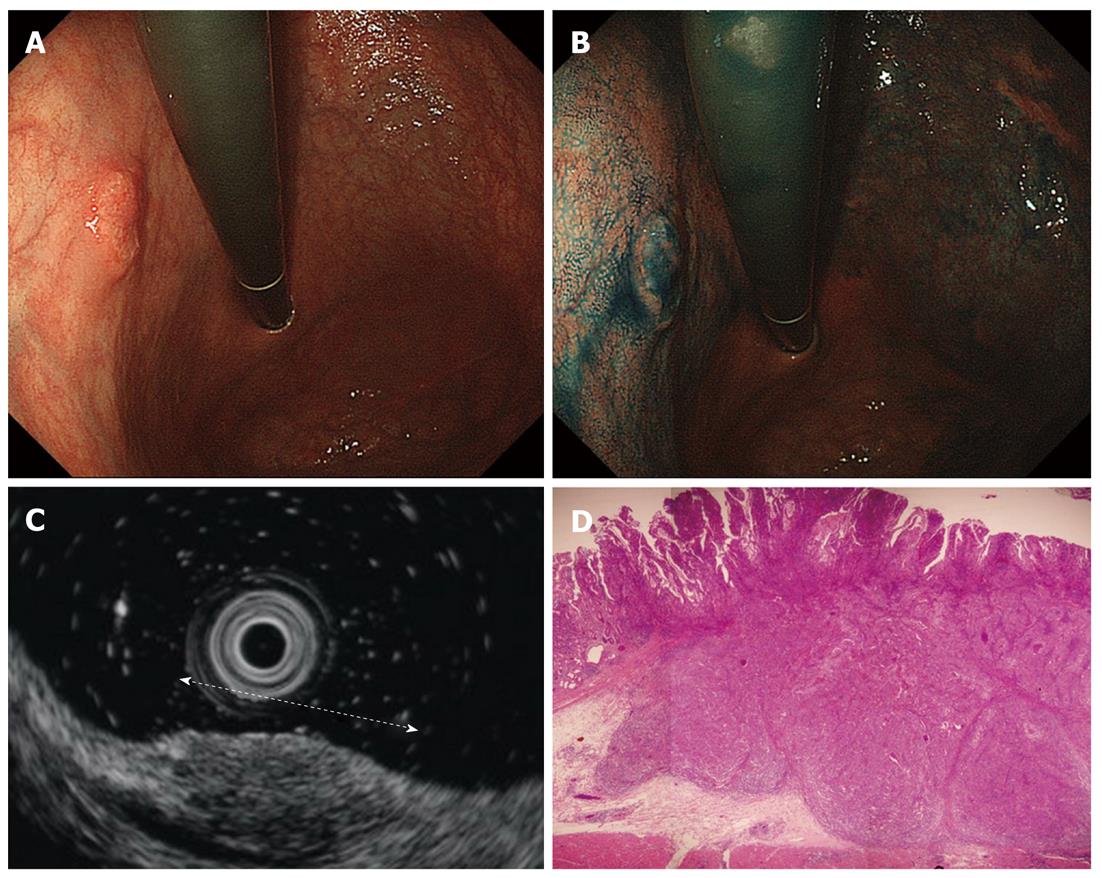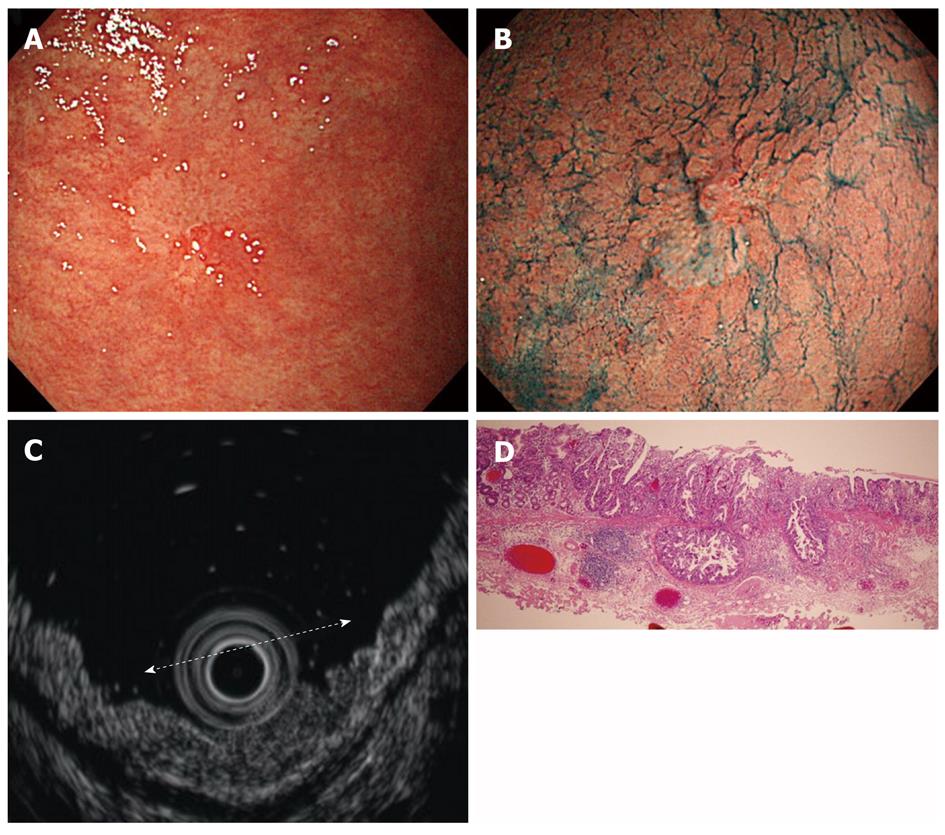Copyright
©2012 Baishideng Publishing Group Co.
World J Gastrointest Endosc. Jun 16, 2012; 4(6): 218-226
Published online Jun 16, 2012. doi: 10.4253/wjge.v4.i6.218
Published online Jun 16, 2012. doi: 10.4253/wjge.v4.i6.218
Figure 1 Scheme of the depth of esophageal cancer invasion.
Figure 2 Differences in endoscopic ultrasound features with quality of water used for irrigation.
A: Water from a faucet ; B: Deaerated water.
Figure 3 Endoscopic ultrasound procedure for early esophageal cancer as performed at the National Cancer Center Hospital.
A: Endoscopic features after washing mucus and saliva from the lesion; B: Endoscopic features after region is filled with deaerated water. Endoscopic ultrasound (EUS) can be performed under direct vision of the lesion; C: EUS features.
Figure 4 Endoscopic ultrasound features of normal esophageal wall.
Each numbered circle, 1-9, with a white arrow, indicates the corresponding numbered tissue layer, first through ninth.
Figure 5 Findings for an m1 cancer of the esophagus.
A: Endoscopic features. A reddish depressed lesion was located on the anterior and left wall of the middle esophagus; B: Endoscopic features after iodine dye. Biopsy specimens showed squamous cell carcinoma; C: Endoscopic ultrasound (EUS) features. The white dotted line indicates the extent of the lesion. EUS revealed an irregularity of the first layer and a slight thickness of the second layer; D: Pathological findings. The tumor was confined to the epithelium. (Hematoxylin and eosin stain, × 40).
Figure 6 Findings for an m2 cancer of the esophagus.
A: Endoscopic features. A reddish flat lesion was located on the anterior wall of the middle esophagus; B: Endoscopic features after iodine dye. Biopsy specimens showed squamous cell carcinoma; C: Endoscopic ultrasound (EUS) features. The white dotted line indicates the extent of the lesion. EUS revealed a thickness in the second layer and a disappearance of the third layer. The yellow line with an arrow indicates the intact fourth layer; D: Pathological findings. The tumor was confined to the lamina propria. (Hematoxylin and eosin stain, × 100).
Figure 7 Findings for an m3 cancer of the esophagus.
A: Endoscopic features. A reddish flat and partially elevated lesion was located on the posterior wall of the middle esophagus; B: Endoscopic features after iodine dye. Biopsy specimens showed squamous cell carcinoma; C: Endoscopic ultrasound (EUS) features. The white dotted line indicates the extent of the lesion. EUS revealed a thickness of the second layer and a disappearance of the third and fourth layer. The fifth layer seemed to be intact; D: Pathological findings. The tumor was reaching and partially invading the muscularis mucosae. (Hematoxylin and eosin stain, × 40).
Figure 8 Findings for an sm1 cancer of the esophagus.
A: Endoscopic features. A depressed, white, flat lesion was located on the posterior wall of the middle esophagus; B: Endoscopic features after iodine dye. Biopsy specimens showed squamous cell carcinoma; C: Endoscopic ultrasound (EUS) features. The white dotted line indicates the extent of the lesion. EUS revealed a thickness of the second layer and a disappearance of the third and fourth layer. The fifth layer seemed to be slightly irregular; D: The tumor was invading the submucosal layer to about 170 μm in depth. (Hematoxylin and eosin stain, × 40).
Figure 9 Findings for an sm2 cancer of the esophagus.
A: Endoscopic features. A depressed lesion was located on the posterior and right wall of the middle esophagus; B: Endoscopic features after iodine dye. Biopsy specimens showed squamous cell carcinoma; C: Endoscopic ultrasound (EUS) features. The white dotted line indicates the extent of the lesion. EUS revealed a thickness of the second layer and a disappearance of the third and fourth layer. The fifth layer had become thin, but the sixth layer was intact; D: Pathological findings. The tumor was invading the submucosal layer to a 320 μm depth. (Hematoxylin and eosin stain, × 40).
Figure 10 Endoscopic ultrasound procedure as performed at the National Cancer Center Hospital when it is difficult to approach lesions horizontally.
A: Elevated lesion with central depression was located on the greater curvature of the angle; B: The lesion could be approached horizontally when using a multi-bending endoscope; C: Endoscopic ultrasound features after region is filled with deaerated water.
Figure 11 Endoscopic ultrasound features of normal gastric wall.
Each numbered circle, 1-5, with a white arrow, indicates the corresponding numbered tissue layer, first through fifth.
Figure 12 Findings for an m cancer of the stomach.
A: Endoscopic features. A depressed lesion with surrounding elevation was located on the greater curvature of the antrum; B: Endoscopic figure after indigo carmine dye. Biopsy specimens showed adenocarcinoma; C: Endoscopic ultrasound (EUS) features. The white dotted line indicates the extent of the lesion. EUS revealed an irregularity of the first layer and a slight thickness of the second layer; D: Pathological findings. The tumor was confined to the lamina propria. (Hematoxylin and eosin stain, × 40).
Figure 13 Findings for an sm2 cancer of the stomach.
A: Endoscopic features. An elevated lesion was located on the posterior wall of the upper gastric body; B: Endoscopic features after indigo carmine dye. Biopsy specimens showed adenocarcinoma; C: Endoscopic ultrasound (EUS) features. The white dotted line indicates the extent of the lesion. EUS revealed a thickness of the second layer and a thin third layer, but the fourth layer was intact; D: Pathological findings. The tumor was invading the submucosa massively. (Hematoxylin and eosin stain, × 12.5).
Figure 14 Findings for an sm1 cancer of the stomach.
A: Endoscopic features. A white, flat lesion with central elevation was located on the greater curvature of the angle; B: Endoscopic features after indigo carmine dye. Biopsy specimens showed adenocarcinoma; C: Endoscopic ultrasound (EUS) features. The white dotted line indicates the extent of the lesion. EUS revealed a thickness of the second layer and a slightly irregular third layer; D: Pathological findings. The tumor was invading the submucosal layer to a 400 μm depth. (Hematoxylin and eosin stain, × 40).
- Citation: Yoshinaga S, Oda I, Nonaka S, Kushima R, Saito Y. Endoscopic ultrasound using ultrasound probes for the diagnosis of early esophageal and gastric cancers. World J Gastrointest Endosc 2012; 4(6): 218-226
- URL: https://www.wjgnet.com/1948-5190/full/v4/i6/218.htm
- DOI: https://dx.doi.org/10.4253/wjge.v4.i6.218










